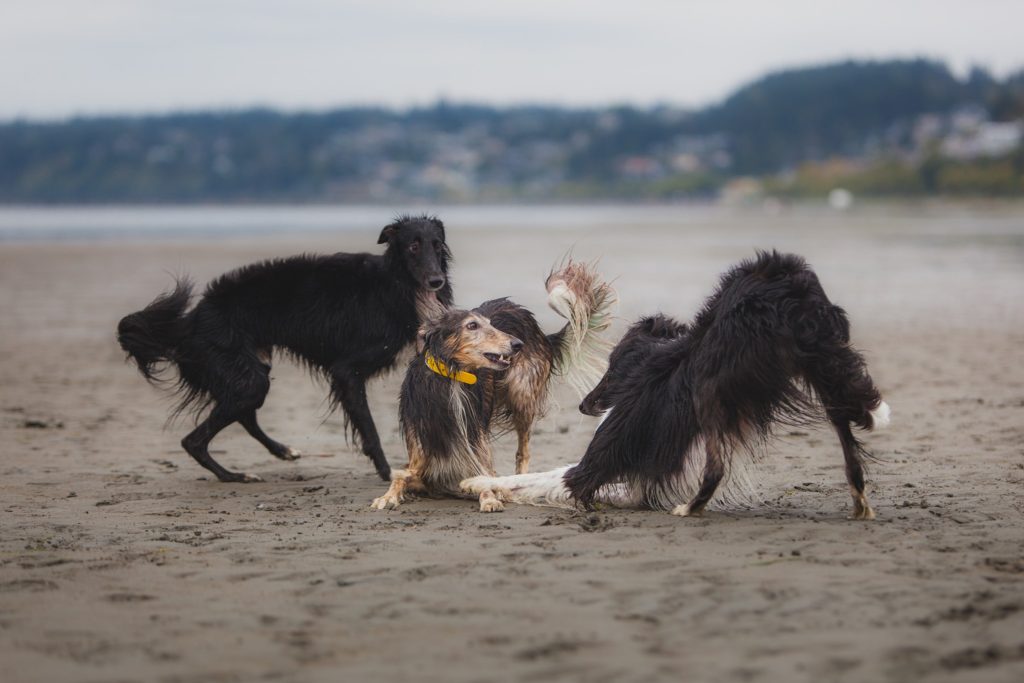It is our hope that you will take the time to explore the world of Silken Windhounds and read the most frequently asked questions that our members have compiled.
The Silken Windhound is an established breed with an Official Breed Standard approved by the International Silken Windhound Society.
Anyone who plans to breed Silkens must adhere to the criteria set forth in the Standard. No breeder has the right or prerogative to change any detail of the Silken Windhound Breed Standard to accommodate his/her own breeding goals.

FAQ about Silken Windhounds
In the early 1980’s, Kristull Kennel embarked on the journey to create the Silken Windhound. The foundation dogs were selected from some of the top winning show and performance Borzoi kennels, Whippet, plus some individual dogs from a line of Whippet-based lurchers. The result is an elegant, medium-sized hound with long hair.
Our parent club, the International Silken Windhound Society (ISWS) is working towards acceptance into the AKC Foundation Stock Service program.
A high-quality meat- or poultry-based kibble is what many people choose, with variations for puppies and nursing mothers. A growing number of our members and owners feed carefully formulated raw food diets with success. Talk to the breeder, as well as your veterinarian, before settling on a diet. Remember pregnant and lactating bitches will need a different caloric intake than a spayed animal; and puppies have different nutritional requirements than adult dogs.
Silken Windhound boys are as sweet and loveable as the girls are, if not more so! Overall, sex differences are less pronounced in this breed than in some others. Males, in general, will have a heavier coat than the females. The males also tend to be somewhat larger and heavier than the females. Intact (unspayed) females have the issue of coming into season (heat) twice a year.
Hair length varies, but can be medium long to very long, wih feathering. Coats can be straight, wavy or curly, and all are acceptable.
All dogs shed. Some Silken Windhounds seem to shed very little while others shed more, but they do not blow their coats like other long-haired breeds such as Golden Retrievers, or even Borzois. A female that is pregnant/nursing will blow her coat after the puppies are born and females may shed out their coats after they have been in season. Puppies will often blow their coats at about 12-18 months of age before their adult coats grow in. Stress, estrus, diet and weather, in addition to genetics, can all affect how much coat they will grow. Males usually hold their coats better than females.
They are all capable of barking and howling, but Silken Windhounds tend not to be a “barky” breed.
Shy, boisterous, dominant, submissive – personalities are as varied as people and it takes some time to find a dog that matches you. Silken Windhounds are friendly towards people and tend not to be territorial or dog-aggressive. The majority of the breed are usually quiet and loving dogs that are comfortable being in the middle of the pack. Overt fighting or dominance struggles are uncommon in this breed. They have a friendly personality that only improves with socialization. They love to run and have fun with others of their kind as well as with humans, but are more than ready to snuggle with you at nap time.
Silken Windhounds seem to have no trouble in any weather. They glory and frolic in snow; splash through puddles; race in the wind; and bask in the sun. They will adapt their exercise and exposure depending on the temperature outside. However, extreme heat for any breed, especially long coated breeds, should be avoided. Shade and plenty of fresh drinking water is a must!
Although generally quiet and easy-going, there are ocasionally the odd dogs that are more active than is the norm for the breed and like to be kept busy.
Some Silken Windhounds are sensitive to drugs in the ivermec family. Any sensitivity can be determined by an easy test. Individuals who are sensitive to these drugs can live totally normal lives without problems with a few changes in some possible drug treatments should the need arise.
A few cases of cryptochordism have been noted. These dogs are neutered and live happy, healthy lives as loving companions.
As in other medium- to larger-sized sighthound breeds, bloat is possible but has occurred very rarely. Mega-esophagus and some grain intolerance have been noted, also rarely. These anomalies, as well as any other issues that arise, are monitored by the ISWS Health Committee to watch for trends.
As with all sighthounds, Silken Windhounds are sensitive to anesthetics. Be sure to talk to your veterinarian when it is time for any surgical procedure on your Silken Windhound.
Most do not tolerate flea collars well, but topical treatments such as Advantage, FrontLine and Revolution are good alternatives. Talk to individual breeders about what they use on their own dogs. Due to the genetic influence of Shetland Sheepdogs in the original make-up of the Silken Windhound, some dogs may be more sensitive to a certain group of medications than others.
You will see red, cream, fawn, brindle, parti-colored (white with patches or spots of other colors), black (usually with white, tan or brindle markings), silver, and white. Check out the websites of various breeders to see photos of the rainbow of colors that are possible.
Find current breeders on our breeder listings page and send them email enquiries; visit their websites or make arrangements to visit their homes. Speak with breeders and find someone you feel comfortable with. A knowledgable breeder is an asset for any puppy buyer. Talk to other Silken Windhound owners about their dogs.
Honestly consider your lifestyle, desires and requirements, then decide if you want a dog to be strictly a companion or if you are considering showing or breeding or performance sports. Then talk with breeders – a good breeder will help you pick the dog or puppy that will best fit you and your family.
FAQ about the International Silken Windhound Society (ISWS)
Information and instructions for registry procedures may be found on the ISWS Registry page on this website
When you purchase a Silken puppy, you can choose the pup’s name unless it has already been registered. Usually, the breeder will give you general guidelines to follow if they have any preference on naming style and be sure to include their kennel name in the name out of courtesy. Being able to put our kennel name on a dog we breed is one of the “perks” of breeding. It shows with pride what we breed in our kennels, and your puppy will always be an ambassador for his/her breeder.
You can download the Membership form from this site and fill it out. You will also need to have a current member sponsor your membership application.
You can search the owner list for those people in your area that have Silkens, go out, and meet them. If they are members of the ISWS, you can ask them to sponsor your membership.
